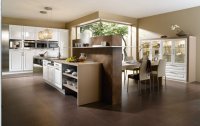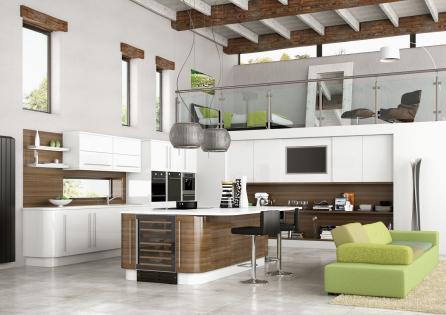It’s one of the most substantial renovations a homeowner can make and one that can add enormous value to a home, if done well. If you’re thinking of updating your kitchen, here are six top trends in kitchen design this year.
1. Cleaner lines
Depending on the space available, many people are opting for kitchens that don’t ‘look’ like the traditional kitchen. That translates into fewer wall cabinets, a more open, streamlined space and less ornamentation including on cabinet doors which are often just a slab. To offset what could be a ‘too cool’ look, benchtops might have some colour or a self-pattern and coloured glass splashbacks are very popular.
2. Updated layouts
Just as enjoying food together is an important cultural activity, being able to socialise while preparing it is increasingly important. For many homeowners – for example in smaller houses or in apartments – this is a given, but even larger and older homes are opening up their kitchen to living and outdoor areas.
One home renovator in Bossley Park in Sydney’s west said they knocked down a wall and opened up their kitchen so it became one larger space with the living room, dining room and rear terrace. “Instead of three separate rooms, we’ve got one large room which is open plan but compartmentalised, and it all flows on to the terrace. It’s made an enormous difference to our use of the terrace and our socialising. And it’s made a big difference to me because I don’t feel left out,” says Diane, a business manager with a local school.
The traditional triangle — with the stove, refrigerator and sink forming its three points — is no longer the focus of kitchen design. Instead, restaurant-inspired workstations are being set up.
3. Docking stations
Beginning in the 1990s, with the rise of home computers, contractors started adding office areas to kitchens in new-construction homes, and the trend soon moved to kitchen renovations. But those office spaces are falling out of favour, because in most homes they quickly became a junk area where bills, receipts, recipes, kids’ school permission slips, and the like got tossed into a pile to be ignored. “Office space is not disappearing” from the kitchen, explains builder Shaun Murphy of Sydney’s northern beaches “but morphing. It’s becoming a message centre and docking station.”
Charging cords and outlets for hand-held devices that live in a countertop cubbyhole can be hidden with a slide-up door, and upper areas containing pockets for kids’ stuff, key hooks, and electronics storage can be masked by doors that close when guests arrive.
4. Varied cabinet choices
Cabinets come in a wider array of materials and configurations than ever before. Among the most popular new designs are those with doors that open not with the traditional left or right swing, but by lifting up garage-door-style, by retracting into the sides of the cabinet, by operating as a bi-fold, or even by sliding. All of these options offer increased efficiency for the cook or server. If you use a particular upper cabinet often, for example, you can keep it open while making dinner rather than taking each ingredient out in advance and cluttering up the counter. And if there’s a sliding door under the sink, it gives you access to the trash can until you’re finished preparing food without causing an obstruction to bump your knee on.
Soft-closing cabinets and drawers are everywhere. “If you have a fight with your spouse and slam a door,” jokes Murphy, “it doesn’t slam anymore.” Lighted glass-front top cabinets are also finding fans (LED bulbs make the ambient glow more cost-efficient), as are lights inside drawers and base cabinets, often activated by motion sensors when you open them.
5. Maximised space
The trend toward organising and simple lines is forcing kitchen designers to use every inch of space as efficiently as possible. It starts with the frameless look and extends to pull-out drawers in the cabinets that allow the whole depth to be used rather than just the front, spacious refrigerated beverage drawers in the island, and pull-out spice racks in what once might have been dead space. “There shouldn’t be any cabinet that’s just a door that opens with a shelf inside anymore,” says Murphy, who also favours roll-out storage under banquet seating.
6. State-of-the-art appliances
To amateur chefs and busy home cooks, beautiful designs are nice but will always play second fiddle to appliances. This is what Shaun finds is popular with his clients.
* Built-in espresso machines
The latest machines, plumbed right into the water source, are pricey but give the family barista steamed milk, espresso, latte, cappuccino, hot chocolate, and, oh yeah, freshly ground coffee at the touch of a button.
* New Finishes
“Stainless is still king,” says Murphy. But there are more options than ever in appliance colours, so if you’re looking to make a statement, you’ll have no shortage of choices, particularly at higher price points. Several manufacturers are making matte black appliances, which fit well with contemporary design. Sleek glass appliances are making inroads. Rubbed bronze appliances are also available, and work well alongside copper sinks and warmer hardware metals.
Another option is a finish that hides the appliance. The concept of cabinet-matching panels on refrigerators and dishwashers is familiar, but today the look has become even more streamlined. The German kitchen manufacturer Poggenpohl, for example, has “panels that match the cabinetry in such a smooth, flat line that it’s really hard to tell the appliances are even there,” according to Murphy.
* Double ovens
Wall-mounted double ovens have been common for decades, but now something new has hit the stores: check out the double ovens that look just like standard ranges, but have a second oven instead of a bottom drawer for pots and pans. This appliance offers flexibility — you can cook two dishes at once using different temperatures — and energy efficiency, since, for a smaller meal, you can use only the more compact unit. A double oven is more expensive than a standard model, but if you plan to stay in your house long-term, it could be worth the investment.
* Warming Drawers
These are not a new idea, but with the emphasis on ease and efficiency, they’re becoming increasingly popular. They can proof your dough and crisp your pizza, and they now have timers, so those dinner rolls will no longer be forgotten.
* Steam Ovens
A must for serious home chefs, steam ovens use steam instead of dry heat to cook foods and can make everything from vegetables to super-moist cakes; some can brown as well. In many kitchens, they’re replacing microwaves, since steam ovens don’t dry out foods the way microwaves often do.
* Induction Cooktops
Like frameless cabinets, induction cooking has been around longer than you might have thought; it was introduced to the general public in the 1950s. Rather than a burning ring or red-hot coils on the stove’s surface, induction uses electromagnetism to heat pans directly. If your pan is half off the area that half won’t cook. The easy-to-clean solid surface stays cool to the touch and requires as little as half as much time as a standard range to cook food.



















__small.png)










